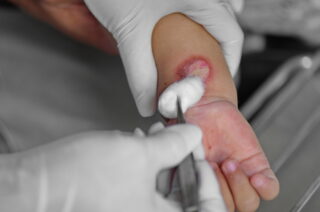
8230 Old Courthouse Road
Suite #430
Tyson’s Corner, VA
1-833-MY-BURNS

More Legal and Health Articles
Should Burn Wounds Be Covered?

Burn wounds are painful injuries that require careful attention to promote healing and prevent complications. One common question that arises when caring for burn wounds is whether they should be covered or left exposed to the air. The answer depends on several factors, including the severity of the burn, the stage of healing, and the recommendations of healthcare professionals.
In this blog post, we’ll explore the importance of covering burn wounds, the benefits of different types of dressings, and when it may be appropriate to leave burn wounds uncovered.
Protection from Infection: One of the primary reasons for covering burn wounds is to protect them from infection. Burned skin is more vulnerable to bacterial colonization and infection due to the loss of the skin’s protective barrier. Covering the wound with a sterile dressing helps create a barrier against bacteria, dirt, and other contaminants, reducing the risk of infection and promoting healing.
Moist Wound Healing: Many healthcare professionals advocate for moist wound healing, which involves keeping the burn wound moist and hydrated to facilitate the body’s natural healing processes. Moist wound environments have been shown to promote faster wound closure, reduce scarring, and minimize pain. Covering burn wounds with appropriate dressings helps maintain a moist environment, allowing the wound to heal more efficiently.
Pain Management: Burn wounds can be extremely painful, especially during the early stages of healing. Covering the wound with a dressing can help alleviate pain by providing a protective barrier against friction, air exposure, and external stimuli. Additionally, some dressings contain ingredients such as lidocaine or hydrogel that provide pain relief and comfort to the patient.
Prevention of Dehydration: Exposed burn wounds can lose moisture rapidly through evaporation, leading to dehydration and delayed healing. Covering the wound with a dressing helps retain moisture and prevent excessive fluid loss, promoting a more favorable environment for healing. In cases of severe burns or large surface areas, preventing dehydration is crucial for maintaining overall fluid balance and preventing complications such as hypovolemic shock.
Reduced Risk of Scarring: Properly covering burn wounds during the healing process can help minimize scarring and improve cosmetic outcomes. By creating a moist and protected environment, dressings support the growth of new skin cells and reduce the formation of scar tissue. Additionally, some dressings contain silicone or other scar-reducing ingredients that further promote favorable wound healing outcomes.
While covering burn wounds is generally beneficial for promoting healing and preventing complications, there are some situations where leaving the wound uncovered may be appropriate:
Minor Burns: For minor burns that are superficial and unlikely to become infected, leaving the wound uncovered may be sufficient. However, it’s essential to monitor the wound closely for signs of infection or delayed healing.
Early Debridement: In some cases, healthcare professionals may recommend leaving burn wounds uncovered during the early stages of debridement, where dead or damaged tissue is removed to promote healing. Once the wound is clean and free of debris, it may be covered with appropriate dressings to facilitate further healing.
Specific Treatment Protocols: In certain circumstances, such as with specialized treatments like negative pressure wound therapy or enzymatic debridement, healthcare professionals may opt to leave burn wounds uncovered to facilitate the effectiveness of the treatment.
In conclusion, covering burn wounds with appropriate dressings is generally recommended to promote healing, prevent infection, and reduce pain and scarring. However, the decision to cover or leave burn wounds uncovered should be made in consultation with healthcare professionals based on the individual patient’s needs and the specific characteristics of the burn injury. Effective wound care requires careful assessment, ongoing monitoring, and adherence to treatment protocols to achieve optimal outcomes for patients recovering from burn injuries.
Attorney Paul Samakow has a national practice representing burn injury survivors. If you or a loved one has suffered a burn injury, please call 1-833-MY-BURNS and be sure to visit his website www.nationalburnattorney.com for additional resources.
Other Articles You May Find of Interest...
- How Life Care Planning Supports Long-Term Recovery
- Why Hire a Martinsville Auto Accident Attorney for Whiplash from a Rear-End Crash?
- Negotiating with Insurance: Tactics They Use to Deny Injury Claims
- Accused of DWI When You’re Innocent? 5 Ways to Cope With the Trauma and Protect Yourself Legally
- Ways a Catastrophic Injury Can Affect Your Life
- How Accident-Related Injuries Affect Long-Term Wellness and What Patients Should Know Early On
- What Type of Accidents Can Result in Spinal Cord Injuries?














